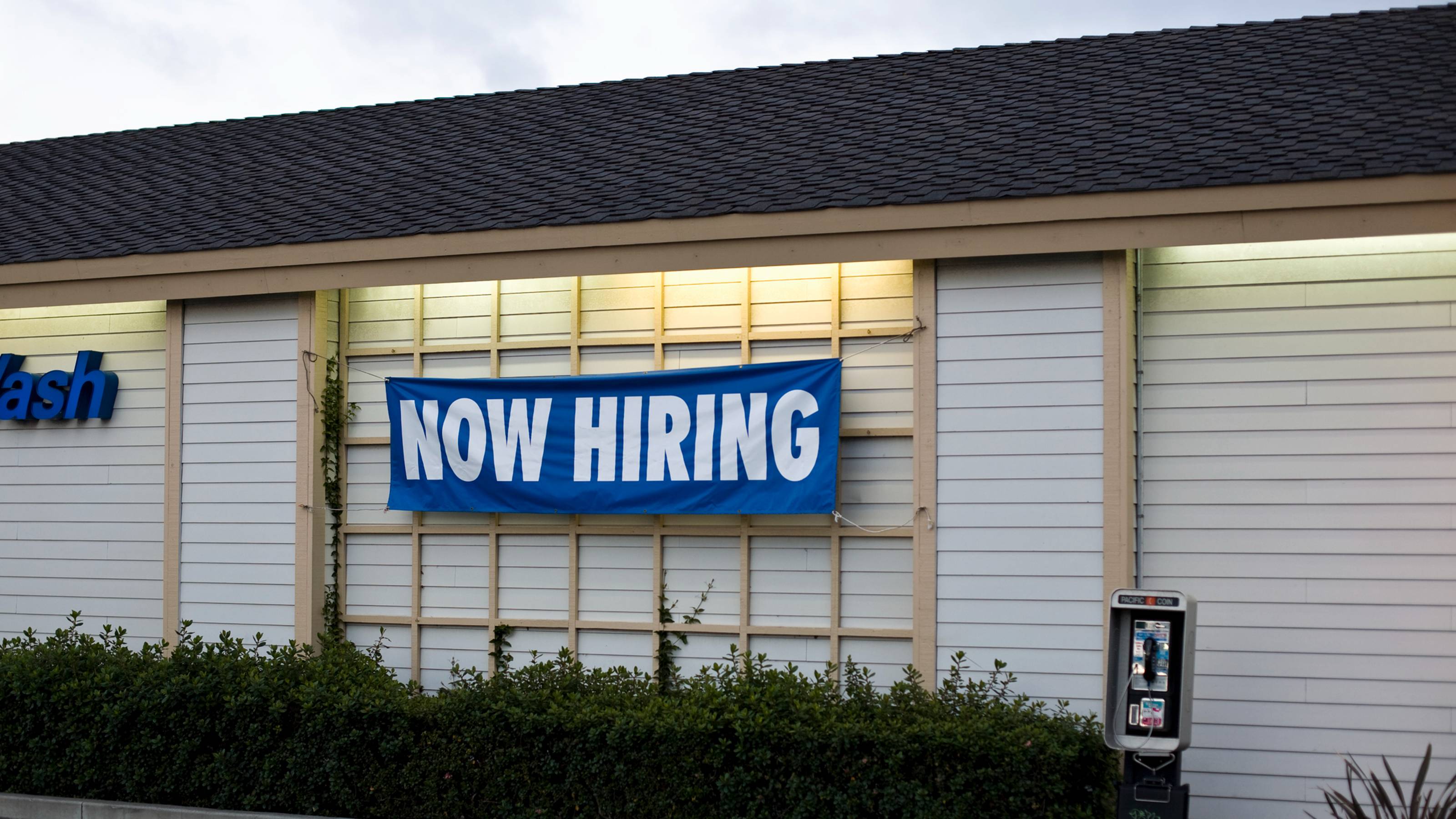
A soft October jobs report gives the Federal Reserve cover to keep interest rates unchanged at the next Fed meeting, experts say. Just remember that the "data dependent" central bank will see one more jobs report – and two inflation readings – before it convenes for the last time in 2023, they add.
U.S. nonfarm payrolls expanded by just 150,000 last month, the Bureau of Labor Statistics said Friday. That was short of economists' estimate for 170,000 new hires, and far softer than the average of 258,000 jobs per month created over the past year.
Experts said the headline number was distorted by the auto workers strike. Were it not for that labor action, hiring would have grown by about 180,000 last month.
Although September's sizzling payrolls report was revised down by 39,000, payroll expansion of 297,000 was still almost twice the size of October's job creation. August's figures were also revised lower, to 165,000 new jobs from an initial reading of 227,000.
The unemployment rate, which is derived from a separate survey, ticked up to 3.9%, or the highest level since January 2022.
The slowdown in hiring gives the Fed's rate setting committee, the Federal Open Market Committee (FOMC), evidence that the labor market is cooling, experts say. That, in turn, gives the FOMC cover to once again stand pat on interest rates.
The Fed made the widely expected move of leaving interest rates unchanged at a 22-year high when it wrapped up its regularly scheduled two-day policy meeting on November 1. And markets very much expect the central bank to go for a third straight "hawkish pause" at the December confab. As of November 3, interest rate traders assigned a 96% probability to the Fed pausing next month, per CME Group's FedWatch Tool.
With the October jobs report now a matter of record, we turned to economists, strategists and other experts for their thoughts on what the data means for markets, macroeconomics and monetary policy going forward. Please see a selection of their commentary, sometimes edited for brevity or clarity, below.
Jobs report: the experts weigh in

"The labor market remains front and center as the Fed considers the future of monetary policy. September's job report was much stronger than anticipated which made today's report even more important after the Fed paused for the second meeting in a row earlier this week. The outlook was for job growth to slow, which it did. Additionally, the high NFP number from September was revised lower. The headline unemployment number moved higher at 3.9% and average hourly earnings came in as expected at 0.2% The overall take from the report is the labor market is beginning to cool in a way which should allow inflation to continue to moderate and the Fed to stop raising interest rates. Bond and stock markets are rallying on this report." – Steve Wyett, chief investment strategist at BOK Financial
"This is a very Fed-friendly report, with job growth slowing, the jobless rate rising, and wages cooling. The only wrinkle is that the labor force shrank, as Chair Powell is counting on rising participation and population growth to increase the labor supply faster than demand to support a further easing in inflation pressures. Still, the overall softness in the report will go a long way to keeping the Fed on the sidelines for a third straight meeting in December." – Sal Guatieri, senior economist at BMO Capital Markets
"Today's report, unlike GDP last week, was a promising sign for the Fed. Wages cooled and, even accounting for the impact of auto strikes, the pace of jobs being added appears to be cooling relative to the beginning of the year. The Fed will want to see more evidence that this labor market cooling represents a trend before they make a decision on any policy changes in December." – Andrew Patterson, senior economist at Vanguard
"The jobs market looks to be softening after all. Employers added 150,00 new jobs in October after an eye-popping (and downwardly revised) 297,000 gain in September. Admittedly, the headline gain in October would have been even stronger were it not for a 33,000 decline in motor vehicle and parts manufacturing that reflected the recent UAW strikes. However, with payrolls rising at an average of 204,000 over the past three months, the trend in hiring has moderated from the 300,000+ pace registered earlier this year." – Sarah House, senior economist at Wells Fargo Economics
"The data reinforce the relatively stable employment numbers we've seen in recent months. Average hourly earnings increased a modest 0.2% month over month and 4.1% year over year. Combined with more favorable productivity numbers recently, wage pressures appear to be moderating. This labor environment gives the Fed some breathing room as it continues to evaluate additional rate increases to help bring down inflation. Overall, I remain optimistic that the economy is continuing on a slow takeoff trajectory rather than heading toward a recession or even a soft landing." – David Royal, chief financial and investment officer at Thrivent
"The payroll report will do nothing but support the Fed's preference that Powell clearly implied on Wednesday to keep rates unchanged at its December meeting. While there is more than five weeks before the next FOMC meeting, the economic data would have to surprise substantially to the upside to make the possibility of a December hike truly debatable. While another Fed 'skip' in December certainly does not guarantee the Fed is done hiking rates, the Fed would absolutely be willing to hike after an extended pause if warranted, the odds that the Fed is done hiking continues to rise." – Greg Wilensky, head of U.S. fixed income at Janus Henderson Investors
"Nonfarm job creation in October was below expectations but still strong by historical standards while September's job creation was revised down by 39,000. The rate of unemployment increased due to a decrease in the civilian labor force as well as a decline in household employment, which contrasted with the increase in the nonfarm payroll number." – Eugenio Alemán, chief economist at Raymond James
"The October employment report sends a clear signal that the labor market is cooling. A broad range of measures fell during the month, including employment, labor force participation and wage growth. Furthermore, there were substantial downward revisions to prior month job gains. NAFCU continues to believe that Fed hikes are finished during this cycle, but a couple more reports like this one will have the FOMC considering a rate cut as early as Q1." – Curt Long, chief economist at the National Association of Federally-Insured Credit Unions
"Easing wage pressures back towards long-term averages are a welcome sign at the moment for markets given that has been one of the pillars slowing the pace of inflation. And the pace is one of easing as opposed to 'falling off a cliff' which alleviates concerns that the U.S. consumer may run out of gas heading into 2024." – Stephen Kolano, chief investment officer at Integrated Partners
"The jobs report this morning supports the view that the Fed will no longer have to raise rates. Labor markets are normalizing, with both the headline number and the 101,000 downward revisions of the past two months supporting a cooling job market. Given that we have both inflation reports and another jobs report before the next Fed meeting, market reactions are likely to be muted, but this certainly is a positive for the bond markets and yields. One factor that could concern the Fed is wage inflation, which remains at an elevated level of 4.1% year-over-year." – Ivan Gruhl, co-chief investment officer at Avantax
"A positive sign today for the Fed's fight against inflation as job growth came in just below expectations, resulting in a slightly higher unemployment rate. This weaker labor data provides affirmation to market participants that the Fed's 'pause' decision earlier this week was likely the correct course of action as we approach the end of what has been a turbulent economic year, especially following September's dramatic labor expansion." – Ben Vaske, senior investment strategist at Orion Portfolio Solutions
"After years of incredible strength, the labor market could finally be slowing. The topline miss, plus downward revisions and higher unemployment, deliver a strong message to Jerome Powell and the Fed. Further tightening is now highly unlikely, and rate cuts could be back on the table next year. Stock market bulls couldn't be more pleased by today's jobs report." – David Russell, global head of market strategy at TradeStation
"The number of jobs added in October was a tad lighter than expected at 150,000, but labor strikes in many segments of the economy distort the full picture. Still, the white-hot labor market that we saw in September cooled in October, and unemployment rose fractionally as well. Slowing employment data should slow the Fed providing relief to investors. Interest rates are likely to fall further, in the near-term at least, offering a boost to both bond and stock prices. As new hiring slowed, wages also cooled with average hourly earnings rising 0.2% month-to-month, translating to a gain of just over 4% year-over-year. These trends validate the Fed’s decision to pause. They also underline a 'not too hot/not too cold' backdrop which will be welcomed news by investors who, up until recently, had been concerned about things overheating." – George Mateyo, chief investment officer at Key Private Bank
"The jobs report provides ample evidence of continued normalization in the labor market, with October numbers falling in line with pre-pandemic growth, as well as an expected downward revision to the gains estimated in August and September. Alongside ongoing deceleration in wage growth, these headline numbers augment the potential for a soft landing, where interest rates prompt a slowdown in job growth, but conditions remain healthy to avoid layoffs and a rise in unemployment. With elevated workforce demand, and nearly 1.5 job openings for every unemployed worker, UKG anticipates a continued cooldown, rather than collapse, in the labor market as supply and demand adjust to a more sustainable trajectory of growth." – Noah Yosif, lead labor economist at UKG







